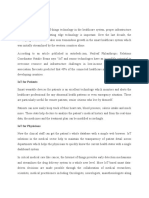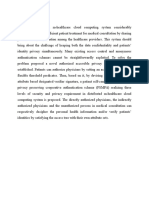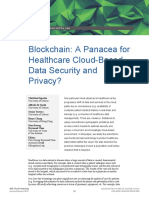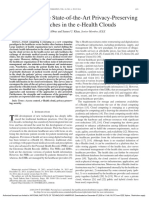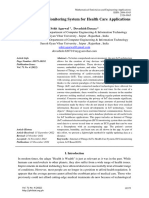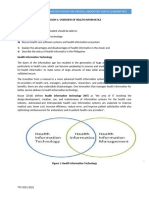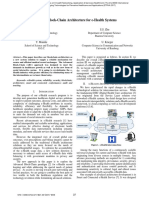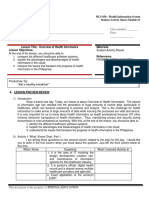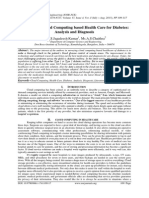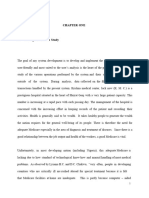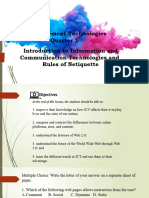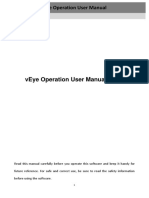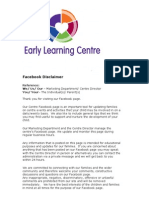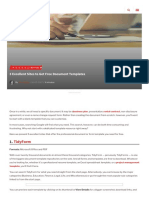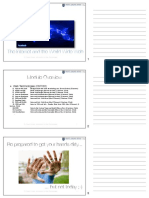1.
INTRODUCTION
E-Health Care is an emerging field of medical informatics, referring to the delivery of health
services and information using the Internet and related technologies. is the most important
source in the healthcare society. E-health Care system is now being popularized globally.
Implementing the EHealth Care[1] system will have more advantages such as online services
for teleconsultation (second medical opinion), e-prescription, e-referral, telemonitoring,
telecare etc. E-Health Care system provides high level of security and cost-effective use of
patients records, information and communication in support of healthcare and health related
issues. The usage of modern E-Health Care system meets needs and demands of patients,
healthcare professionals at a higher rate. Medications, consultations, e-prescriptions etc., can
be provided to the patients directly in the internet itself which reduces the time, and energy
from travelling place to place. Queries and comments can be made directly from anywhere
around the world. There will be no need for carrying around the hardcopies of reports,
prescriptions etc. All the softcopies can be directly uploaded in the Cloud which can be
retrieved whenever and wherever required.
Cloud computing is one of the popular and evolving technologies in the world of computers. It
is a set of hardware and software that work together to deliver services on a large scale over a
particular network. Users can access files and other data applications from any other data that
uses the internet connection. Cloud computing aims at providing many services of computing
to the end users through online and internet servicing. Usage of Cloud enhances the level of
security. Remote patient monitoring is made possible through medical providers to
electronically observe a patient remotely using medical monitoring devices and
telecommunication networks. For example, a medical practitioner can monitor a patient’s heart
beat or blood pressure. This type of remote monitoring is cost-effective when used for patients
with chronic conditions, the elderly, and patients recovering from specific conditions. E-Health
technologies with the potential to have a significant future impact on patient care include
Internet-enabled applications for chronic diseases which could help increase citizen
empowerment in health maintenance and decision making supporting self-care.
1
�The working system of this dissertation implements three modules named as patient, doctor,
and government as admin. In this system patient can create their appointment and can see their
prescription history. Then doctors can see their appointments with patient, can give prescription
to the patients, and can able to see the prescription list of all the patients. In this system
Government can serve as an admin. Admin are able to see doctor list, Admin can see Location
wise disease details, Patient list, List of appointment details, and Prescription details of all the
patients. Admin have authority of new doctors registration, they can delete the doctors who are
not working yet.
2
� 2. LITERATURE SURVEY
E- Healthcare system plays a major role in the society. It monitors the health condition
and helps in giving appropriate medical treatments. This system aims at gathering and storing
patient’s details and sharing health related information. It also has high legitimate concerns
about patient’s privacy and information security. This system minimizes the infrastructural
barriers for the developing nations. It also extends healthcare systems to the remote and isolated
areas which have limited access to medical technologies, remote health services are provided
through telecommunications. Quality of the service and security are added advantage to the
system. They collect the real time personal information (PHI) and health problems from
patients and transmit them to the healthcare provider for the authorized physicians to decide
on the corresponding treatment. They send the PHI in terms of text and image to the cloud, and
also the other personal queries related to their medical history. In cloud computing, collected
PHI should match the physicians experience to judge the state of the patient and unfortunately,
delegating both storage and computation to the untrusted entity would bring a series of security.
This is where de-duplication comes into play. It is a technique for eliminating duplicate copies
of data, and has been widely used in cloud storage to reduce storage space and upload
bandwidth. Attribute-based encryption has been a preferred encryption technology to solve the
challenging problem of security during data sharing in cloud computing. For every file a
separate key will be provided, which is to be decrypted for using the file further.
Cloud computing is one of the popular and evolving technologies in the world of
computers. It is a set of hardware and software that work together to deliver services on a large
scale over a particular network. Users can access files and other data applications from any
other data that uses the internet connection. Cloud Computing aims at providing many services
of computing to the end users through online and internet servicing. Usage of Cloud enhances
the level of security. Remote patient monitoring is made possible through medical providers to
electronically observe a patient remotely using medical monitoring devices and
telecommunication networks. For example, a medical practitioner can monitor a patient’s heart
beat or blood pressure. This type of remote monitoring is cost-effective when used for patients
with chronic conditions, the elderly, and patients recovering from specific conditions. E-Health
3
�technologies with the potential to have a significant future impact on patient care include
Internet-enabled applications for chronic diseases which could help increase citizen
empowerment in health maintenance and decision making supporting self-care.
R.Wu et al. [1], presented a unified logical EHR model to represent hierarchical
structures of EHRs from different healthcare domains such as pharmacy, primary care, clinic
lab and so on. An EHR data schema composition approach was to integrate different EHR
data schemas to a composite EHR data schema. An access control policy scheme was also
defined based on which access control policies can be specified to regulate the selective
sharing of composite EHRs. Based on the composite EHR data schema, distributed EHR
instances from various healthcare domains can be aggregated into a composite EHR
instance. By enforcing access control policies specified by patients, selective portions of the
composite EHR instance were able to be shared with authorized healthcare organizations.
They designed and implemented a cloud-based EHRs sharing system. The system provided
a web interface for both healthcare providers and patients to manage EHRs and APIs for
third-party applications to leverage for EHRs’ retrieval and aggregation.
Asrul Nizam Asat et al. [2], a web-based system was designed for which dengue
related information can be made freely accessible by all communities. Current network
architecture was determined to ensure the success of data retrieval and information display.
Several application components were developed to support dengue system which included
the front page portal, user tracking capability, statistical information of reported cases,
dengue mortality report and dengue outbreak prediction report. Those modules which are
used to construct the system have been tested functionally. The current setup is only for
PULL method where the data is retrieved by the client when needed.
R. Shiny Sharon, Dr. R Joseph Manoj [3], they have proposed Privacy preserving
techniques for securing the PHI such as Layered model of access structure which solves the
problem of multiple hierarchical files sharing. FH-CP-ABE is implemented which has low
storage cost and computation complexity in terms of encryption and decryption. Deduplication
is implemented which allows only a single instance of a file to be save which saves memory
wastage and time. One drive which connects all of the cloud servers together at the same time.
In future work we will work towards designing a more secured system using AES (Advanced
Encryption Standard (AES) which is stronger in detecting the attacks.
Rahul Shende et al. [4], developed an approach for health data access based on privacy
preserving keyword search on cloud storage for e-healthcare system. Storage Privacy on the
4
� cloud is subject to privacy objectives such as data confidentiality and keyword privacy.
Proposed system builds privacy into e-healthcare systems with the help of the private cloud.
It also provides a solution for privacy preserving data storage by providing efficient key
management and a secure indexing method for privacy-preserving keyword search.
Proposed system builds privacy into ehealthcare systems with the help of the private cloud.
Mrs. Suchitra Shelke, Prof. Babita Bhagat [5], Cloud storage services commonly use
deduplication technique for eliminating redundant data by storing only a single copy of data of
each file of data block which was explained in Side channels in cloud services, the case of de-
duplication in cloud storage by Danny Harnik. Privacy implication of cross-user deduplication
is used in the system and it will be demonstrated as a side channel which reveals the information
about the contents of the files of other users. High savings are offered by cross-user
deduplication. Data deduplication strategies are categorized into two types they are 1) File-
level deduplication 2) Blocklevel deduplication. In file-level de-duplication only single copy
of the file is stored and two or more files are identified as identical if they have the same hash
value. In Block-level deduplication the data file is segmented into blocks and only single block
will be stored. The system could use either fixed size block or variable sized blocks. The
effectiveness of deduplication depends on multiple factors such the type of data, the retention
period and the number of users. By applying this source based deduplication approach, client
will be able to easily identify whether a certain file or block is deduplicated. This can be done
by either examining the amount of data transferred over the network, or by observing the log
of the storage software.
L. de Melo Silva et al. [6], proposed a novel architecture for secure sharing and
storage of health records in the cloud. It made possible a secure storage with file sharing
managed by the user based on an access policy. Also, it allowed access revocation and does
not require users to continuously store keys. The proposal also enables patient and clinician
sovereignty over PHR and EHR. In addition, it allows collaboration through health record
sharing and it allows simple access revocation. It was a step towards secure sharing and
storage of health records in the cloud.
Chun-Ho Ng, Patrick P.C. Lee [7], deduplication is known to effectively eliminate
duplicates for Virtual Machine (VM) image storage which was explained in RevDedup: A
Reverse Deduplication Storage System Optimized for Reads to Latest Backups. Where it
introduces fragmentation that will degrade read performance. RevDedup is introduced here,
which is a deduplication system that optimizes reads to latest VM image backups is using an
idea called reverse deduplication. RevDedup removes duplicates from old data, RevDedup
5
�achieves high deduplication eƥciency with around 97% of saving, and high backup and read
throughput on the order of 1GB/s. Many backup solutions are made by disk-spaced storage
systems which has better I/O performance than other traditional storage systems. Deduplication
is mainly studied in content addressable backup systems. It is also shown to provide space
efficient VM image storage given that VM images have significant content similarities. Here
Deduplication mainly focuses on optimizing storage efficiency and performance. RevDedup
exploits content similarities of VM images using a hybrid of inline and out-of-order
deduplication approaches. It applies coarse-grained global deduplication (inline) to diơerent
VMs and removes any duplicates on the path, and further applies reverse deduplication (out-
of order) to backup versions of the same VM and removes any duplicates from old backup
versions.
Threshold based block removal mechanism is used, that combines hole punching to remove
duplicate blocks of old backup versions and segment compaction to compact data segments
without duplicate blocks to reclaim contiguous space.
R.Wu et al. [8], presented a unified logical EHR model to represent hierarchical
structures of EHRs from different healthcare domains such as pharmacy, primary care, clinic
lab and so on. An EHR data schema composition approach was to integrate different EHR
data schemas to a composite EHR data schema. An access control policy scheme was also
defined based on which access control policies can be specified to regulate the selective
sharing of composite EHRs. Based on the composite EHR data schema, distributed EHR
instances from various healthcare domains can be aggregated into a composite EHR
instance. By enforcing access control policies specified by patients, selective portions of the
composite EHR instance were able to be shared with authorized healthcare organizations.
They designed and implemented a cloud-based EHRs sharing system. The system provided
a web interface for both healthcare providers and patients to manage EHRs and APIs for
third-party applications to leverage for EHRs’ retrieval and aggregation.
Martin Beck [9], proposed Hybrid Approach for a combination of different techniques
which combines to give an integrated result. Liu and Luo proposed rating based privacy
preservation, A novel algorithm which overcomes the curse of dimensionality and provides
privacy proposed anonymizing demonstrator for Making a demonstrator with user friendly
interface and performs Anonymization.
A.S. Shanthi [10], in distributed data mining the dataset may either be horizontally
partitioned data or vertically partitioned data. Each site has complete information about on a
6
�distinct set of entities in case of horizontal partition. In contrast vertical partition consists of
different information in each site.
Slava Kisilevich [11], proposed anonymization technique for hiding individual’s
sensitive data from owner’s record. kanonymity is used for generalization and suppression for
data hiding, though it do not preserve sensitivity of an individual because of background
knowledge and homogeneity attacks of k-Anonymity. The k-anonymity methods mainly focus
on a universal approach that exerts the same amount of preservation for all individuals, without
catering for their concrete needs. The consequence may be offering insufficient protection to a
subset of people, while applying excessive privacy control to another subset.
L. Sweeney [12], the number of privacy models are discussed which are succeeded in
solving the problems such as attribute disclosure and identity disclosure by preserving private
information. Some of popular techniques such as k-anonymity, l-diversity and t-closeness
models. In order to preserve privacy, Sweeney proposed k-anonymity using generalization and
suppression, Generalization involves replacing a value with a less specific (generalized) but
semantically reliable value.
7
�3. PROBLEM STATEMENT AND OBJECTIVE
3.1 Problem Statement
1. Electronic Health Records(EHR) are kept and managed by healthcare institutions.
There is no control with the way records are kept and stored and it is extremely
difficult to grant access to third parties or different healthcare institutions.
2. This is a problem since EHRs contain essential information to treat patients. Such
as clinical history, medications, blood type and so on.
3. However, it is not possible for every remote healthcare organization to implement a
nationwide web application to serve every remote healthcare provider. And it’s
patients because of its own requirements and budget constraints.
4. Using Cloud service to store and manage EHR can be a solution.
8
�3.2 Objective
The primary objective of this project is to define, implement and build a system which
offers support for the hospital management, that can be fulfilled only thorough achieving
by to develop a secure framework for sharing Electronic Health Records over Clouds .
The secondary objectives that will be presented next. One of the objectives of this project
is to enhance the efficiency in usage, that is measured through the expressivity and the
consistency of the graphical user interface. A user is considered to be efficient when
using a system if the time necessary to execute a certain task decreases with each usage.
The framework enables patients at a healthcare provider, to retrieve their EHRs, in
entirety or partially, from a remote healthcare provider. The framework also allows
targeted healthcare providers to authenticate the patients and requesting healthcare
providers before processing a sharing request.
Requested EHRs are encrypted using a shared symmetric key between communicating
healthcare providers. It provides legal basis for the collection, sharing, use and safe
keeping of patient’s health data under the Electronic Health Record Sharing System.
The System provides an information infrastructure platform for healthcare providers in
both the public and private sectors. It will also include a government panel in which
application will not open the identity of a patien t but they can just analyze which disease
comes in what location at what time. So that government can take all the precaution
before.
Another objective is to create a system that allows further improvements, extensions of
the current functionality. The system should be able to offer the opportunity to manage
patient details, doctor’s details, schedule appointments, view prescriptions, order
medicines online and make online payments.
9
�4. PROPOSED SYSTEM
Technical feasibility: The technology used in EHR can be very easily operated and
implemented. The web application can be designed using html, css and javascript and the
software requirements such as database server, web server are the same components used
in any workplace. Mysql can be used for databases and php can be used as a server side
technology. The system has software and hardware components which are easily
available. Thus, it is technically feasible. • Need: Patients are often forced to bring paper
records with them when they change health care providers and their new doctor may have
to rely on them to remember critical details. Therefore, electronic health records (EHRs)
can be used to their fullest potential, different systems must be able to easily exchange
data with one another. Often referred to as interoperability, this allows doctors and their
patients to quickly access the information they need to make informed health care
decisions. • Significance: The secured health records are much effective and have more
benefits such as lowering costs, improving healthcare quality, promoting evidence-based
medications. It also helps in maintaining the records and ensures mobility of the records
10
� 5. FLOW CHART /DATA FLOW DIAGRAM
5.1 DATA FLOW DIAGRAM
Patient:
Book Appointment, View
Appointment History and Prescription
Details, Book Lab test appointment.
Doctor:
view their appointments with patient,
can give prescription to the patients,
view the prescription list of all the
patients. Figure 3.2: System Architecture
Secure health
Government/Admin: record database
View doctor list, view Location wise
disease details, Patient list, List of
appointment details, and Prescription
details of all the patients. Doctors
registration, delete the doctors.
Diagnostic Lab:
Upload lab test report.
5.1 Data Flow Diagram
The existing system is not completely digitized; most of the processes like registration of
patients, sharing their reports, sharing the prescriptions are offline which involve a lot of
paper and consume a lot of time. This project has focused on reducing the amount of
paperwork involved and also reducing the time involved in these processes. Figure 4.1 shows
system architecture. This project has been designed with three modules named as Admin,
Doctor, and Patient. In this system patient can create their appointment and can see their
prescription history. Then doctors can see their appointments with patient can give
prescription to the patients, and can able to see the prescription list of all the patients. In this
11
�system Government can serve as an admin. Admin are able to see doctor list, Admin can see
Location wise disease details, Patient list, List of appointment details, and Prescription details
of all the patients. Admin have authority of new doctors registration, they can delete the
doctors who are not working yet. This information stored continuously and electronically
over time. If necessary, without contact with the location or time, all or part of this
information will be available to authorized persons. Generally, integrated EHR stakeholders
are all members of a society. All healthcare providers are stakeholders and customers. EHR
has a significant change in providing healthcare, reducing errors and increasing impact of
health care. Ease of access to all information on patient history improves care, focuses on
information and thus reduces medical diagnostic errors. The simultaneous availability of
specialized medical centers to the EHR is a considerable benefit.
12
� 5.2 FLOW CHART
A Secure Medical Record Authorization System in Clouds
Patient Government/
Doctor Admin
Registration
Authentication Authentication
Authentication View doctor list
View
Appointment
View Location wise
Book Appointment
disease details
Give
Prescription
View Appointment View Patient list
History
View Prescription View list of appointment
History details
View prescription details
Doctor registration
Delete Doctor
13
�An electronic health record is defined as an electronic version of a medical history of the
patient as kept by the healthcare provider for some time period and it is inclusive of all the
important clinical data that are in line to the care given to an individual by a particular
provider such as progress reports, problems, vaccinations, medications, important signs,
medical history, laboratory data, etc. Electronic Health Record (EHR) is storage, secure
exchange and access to patient information in digital format by several authorized users. This
information includes the patient’s past, present, and future information. The project consists
of these modules i.e. Patient, Doctor,Admin,Diagnostic Lab.
1. Patient: The Patient module consists of Patient registration and Patient login, a profile for
each Patient will be created by filling a registration form. So the Patient have to create profile
for that he will have to register on the portal with some basic information, with the help of
user id and password one can login and book appointment easily. After successfully booking
an appointment the Patient can view appointment history on the portal.
2. Doctor: When the patient books an appointment, he can view the Doctor’s details
including specialization and consultancy fees. So, after giving an appointment to the Patient,
the Doctor can login with his user id and password. When the patient visits to the Doctor, the
Doctor can prescribe necessary medicines, lab test to the patient and can also view
prescription history of the patient.
3. Government/ Admin: The portal will have Government as master admin, the medical
history added by the patient will create a big data so that the Government can analyze and
predict the future problems and can take necessary precautions. The Government panel can
register a new doctor and can verify them, if the details are found false the Government panel
can also delete a doctor. We can take the example of Dengue, in rainy season especially in
Melghat areas, the cases of Dengue increases so with the help of data generated on the portal
we can predict what disease occur in which area or locality, so that the government can take
actions and provide necessary precautions to the specific areas.
4. Daignostic Lab: The Diagnostic lab module consists of login and registration. The new
diagnostic lab can register on the portal. The lab test report of the patients can be uploaded by
the lab technician. This report can be viewed by the patient and the doctor can suggest
prescription to the patient based on that report.
14
� 6. SOFTWARE & HARDWARE REQUIREMENT
• Operating System: Windows 7
• Technology Used: PHP
• Database Used: Mysql
• Library: jQuery
Hardware Component
• System: Core i3 1.80 GHz Processor
• Hard Disk: 500 GB.
• Ram: 4 GB.
15
� 7. IMPLEMANTATION
7.1 System Configuration
Install XAMPP.
Steps:
i. Download: XAMPP is a release made available by the non-profit project Apache
Friends. Versions with PHP 5.5, 5.6, or 7 are available for download on the Apache
Friends website.
ii. Run .exe file: Once the software bundle has been downloaded, you can start the
installation by double clicking on the file with the ending .exe.
iii. Deactivate any Antivirus Software: Since an active antivirus program can
negatively affect the installation process, it’s recommended to temporarily pause
any antivirus software until all XAMPP components have successfully been
installed.
iv. Deactivate UAC: User Account Control (UAC) can interfere with the XAMPP
installation because it limits writing access to the C: drive, so we recommend you
deactivate this too for the duration of the installation process. To find out how to
turn off your UAC, head to the Microsoft Windows support pages.
v. Start the Setup Wizard: After you’ve opened the .exe file (after deactivating your
antivirus program(s) and taken note of the User Account Control, the start screen
of the XAMPP setup wizard should appear automatically. Click on ‘Next’ to
configure the installation settings.
vi. Choose Software Components: Under ‘Select Components’, you have the option
to exclude individual components of the XAMPP software bundle from the
installation. But for a full local test server, we recommend you install using the
standard setup and all available components. After making your choice, click
‘Next’.
vii. Choose The Installation Directory: In this next step, you have the chance to
choose where you’d like the XAMPP software packet to be installed. If you opt for
the standard setup, then a folder with the name XAMPP will be created under C:\
for you. After you’ve chosen a location, click ‘Next’.
viii. Start the Installation Process: Once all the aforementioned preferences have been
decided, click to start the installation. The setup wizard will unpack and install the
16
� selected components and save them to the designated directory. This process can
take several minutes in total. You can follow the progress of this installation by
keeping an eye on the green loading bar in the middle of the screen.
ix. Windows Firewall Blocking: Your Firewall may interrupt the installation process
to block the some components of the XAMPP. Use the corresponding check box to
enable communication between the Apache server and your private network or
work network. Remember that making your XAMPP server available for public
networks isn’t recommended.
x. Complete Installation: Once all the components are unpacked and installed, you
can close the setup wizard by clicking on ‘Finish’. Click to tick the corresponding
check box and open the XAMPP Control Panel once the installation process is
finished.
Import dump SQL file into PhpMyAdmin
i. Log into phpMyAdmin.
ii. Select the destination database on the left pane.
iii. Click on the Import tab in the top center pane.
iv. Under the File to import section, click Browse and locate the file.
v. Check or uncheck the boxes for 'Partial import' and 'Other options'.
vi. From the Format dropdown menu choose 'SQL'.
vii. Click the Go button at the bottom to import the database.
Create your project folder in XAMPP>> htdocs>> and copy all the files in it.
Find an open space in the right pane and right click or on newer versions of Windows,
Click the drop down arrow beside Organize top left, and choose New Folder. Either
method, Type htdocs to replace the blue New Folder text. Then click beside it. Then double
click the htdocs folder to open it.
Start apache server and execute the project on local host.
I. In order to get the dashboard for localhost: search http://localhost in any browser.
II. Now to run your code, open localhost/file.php then it gets executed.
17
�7.2 Implementation Details
A web base platform implementer creates hypertext markup language (HTML), Common
Gateway Interface (CGI) programs, and/or Java scripts and/or applets. The implementation
process resembles software development because it involves using a specific syntax for
creating hypertext structures in HTML or writing programming language code statements in
computer files.
Html: The HyperText Markup Language, or HTML is the standard markup language for
documents designed to be displayed in a web browser. It can be assisted by technologies such
as Cascading Style Sheets (CSS) and scripting languages such as JavaScript. Web browsers
receive HTML documents from a web server or from local storage and render the documents
into multimedia web pages. HTML describes the structure of a web page semantically and
originally included cues for the appearance of the document.
CGI: stands for Common Gateway Interface and provides an interface between the HTTP
server and programs generating web content. These programs are better known as CGI
scripts. They are written in a scripting language. The Network Component provides such a
scripting language.
Scripts : a computer programming language for adding dynamic capabilities to World Wide
Web pages. Web pages marked up with HTML (hypertext markup language) or XML
(extensible markup language) are largely static documents. Web scripting can add
information to a page as a reader uses it or let the reader enter information that may, for
example, be passed on to the order department of an online business. CGI (common gateway
interface) provides one mechanism; it transmits requests and responses between the reader’s
Web browser and the Web server that provides the page. The CGI component on the server
contains small programs called scripts that take information from the browser system or
provide it for display. A simple script might ask the reader’s name, determine the Internet
address of the system that the reader uses, and print a greeting. Scripts may be written in any
programming language, but, because they are generally simple text-processing routines,
computer scripting languages such as PERL are particularly appropriate.
18
�8. RESULT ANALYSIS & DISCUSSION
Screenshot 5.1: Home Page
19
� Screenshot 5.2: Patient Login
Screenshot 5.3: Patient Registration
20
� Screenshot 5.4: Patient Dashboard
Screenshot 5.5: Appointment Booking Form
21
�Screenshot 5.6: Appointment History
Screenshot 5.7: Health Record
22
� Screenshot 5.8: Admin Login
Screenshot 5.9: admin Dashboard
23
� Screenshot 5.10: Doctors List
Screenshot 5.11: Patients list
24
�Screenshot 5.12: Doctor Registration by admin
Screenshot 5.13: Delete Doctor
25
� Screenshot 5.14: Database Tables
Screenshot 5.15: Admin Table Structure
Screenshot 5.16: Contact Table Structure
26
�Screenshot 5.17: Appointment Table Structure
Screenshot 5.18: Doctor Table Structure
Screenshot 5.19: Patient Table Structure
27
�9. CONCLUSION AND FUTURE WORK
A Secure Medical Record Authorization System in Clouds is essential for maintaining
detail about the Doctor, Patient. This project has been designed with three modules
named as Admin, Doctor, and Patient. In this system patient can create their appointment
and can see their prescription history. Then doctors can see their appointments with
patient and can give prescription to the patients, and can able to see the prescription list of
all the patients. In this system Government can serve as an admin. Admin are able to see
doctor list, Admin can see Location wise disease details, Patient list, List of appointment
details, and Prescription details of all the patients. Admin have authority of new doctors
registration, they can delete the doctors who are not working yet.
In future some basic algorithms like ID3 have been used for the allotment of Doctors and
prediction of disease. Further some complex algorithms can be used to improve the
performance of the system.
28
�10. REFERENCE
[1] Shekha Chenthara, Khandakar Ahmed, Hua Wang and Frank Whittaker, “Security and
Privacy preserving Challenges of E-health Sloutions in Cloud Computing”, IEEE Access,
vol 7, 2019.
[2] Asrul Nizam Asat, Faizal Mahat, Rosilah Hassan, Amjed Sid Ahmed, “Development of
Dengue Detection and Prevention System(Deng-E) based upon open data in Malaysia”,
IEEE, 2017.
[3] R. Shiny Sharon, Dr. R Joseph Manoj, “E-health care data sharing into the cloud based on
deduplication and file hierarchical encryption”, International Conference on information,
communication & embedded systems, 2017.
[4] Rahul Shende, Shailesh Kamble and Sandeep Kakde, “Health Data Access in Cloud
assisted
E-healthcare System”, International conference and workshop on Electronics and
Telecommunication Engineering,2016, pp. 169-173.
[5] Mrs. Suchitra Shelke, Prof. Babita Bhagat, “Techniques for Privacy Preservation in Data
Mining”, International Journal of Engineering Research & Technology, Vol. 4 Issue 10,
October2015.
[6] L. de Melo Silva, R. Araujo, F. Leite da Silva, and E. Cerqueira, “A New Architecture for
Secure Storage and Sharing of Health Records in the Cloud Using Federated Identity
Attributes,” in Proceedings of 16th International Conference on e-Health Networking,
Applications and Services (Healthcom). IEEE,oct-2014, pp. 194–199.
[7] “RevDedup: A Reverse Deduplication Storage System Optimized for Reads to Latest
Backups” Chun-Ho Ng and Patrick P. C. Lee The Chinese University of Hong Kong, Hong
Kong Technical Report June 28, 2013.
[8] R.Wu, G-J. Ahn and H.Hu, “Secure Sharing Of Electronic Health Records in Clouds”,in
proceedings of 8th International Conference on Collaborative Computing:Networking,
Applications and Worksharing, IEEE,Oct-2012, pp.711-718.
[9] Martin Beck and Michael Marhofer, “Privacy-Preserving Data Mining Demonstrator”, in
proceedings of 16th International Conference on Intelligence in Next Generation
Networks, IEEE 2012.
29
�[10] A.S.Shanthi, , Dr. M. Karthikeyan, “A Review on Privacy Preserving Data Mining” IEEE
International Conference on Computational Intelligence and Computing, 2012 .
[11] Slava Kisilevich, Lior Rokach, Yuval Elovici, Bracha Shapira, “Efficient Multi-
Dimensional Suppression for K-Anonymity”, in proceedings of IEEE Transactions on
Knowledge and Data Engineering, Vol. 22, No. 3, pp. 334-347, IEEE 2010.
Pingshui WANG, “Survey on Privacy Preserving Data Mining”, International Journal
of Digital Content Techn
30



